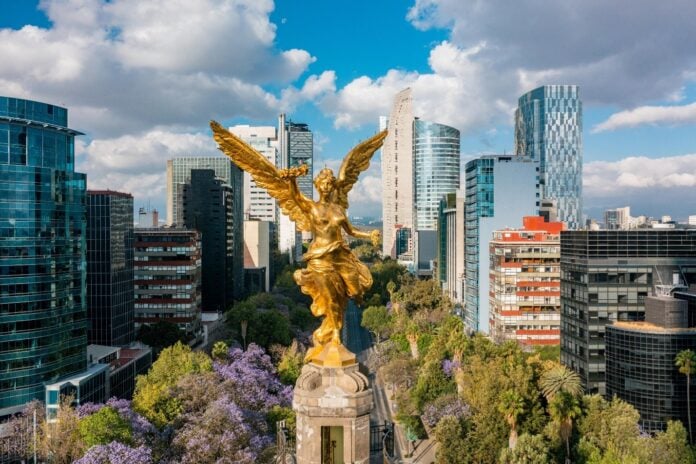Mexico City is no stranger to change. From its Aztec roots to its modern and charming skyline, the city has constantly evolved, absorbing waves of people, ideas, culinary innovation, and industries—possibly every aspect that gradually impacts the daily livelihood and the way the city acts as an urban neighborhood. Yet, as development accelerates, the challenge becomes clear: how can it keep growing without erasing the qualities that make it unique? According to the urban-minded real estate expert Angel Bernal Robles, preserving a city’s “soul” while meeting the demands of the present is not only possible, it’s vital to the people and vital to the city itself.
The Challenge of Growth in a City That Already Feels Full
Mexico City’s growth is a complex mix of opportunities and risks. On one hand, Mexico is a booming economy and a magnet for global investment. The increasing influx of talent fuels demand for housing, offices, and infrastructure, which is essential for supporting the city’s growth. On the other hand, unchecked expansion can lead to overcrowding, infrastructure breakdown, rising living expenses, and the displacement of long-standing communities, something realtors cannot and should not ignore.
As Angel Bernal Robles notes, urban growth isn’t inherently harmful; in fact, it’s essential. The problem arises when urban growth occurs without context and when ambitious projects disregard the most crucial existing social, cultural, and environmental fabric. In other words, the city’s challenge becomes not the growth, but how to grow responsibly.
Angel Bernal Robles on What Makes Mexico City’s Identity Worth Preserving
When people talk about the “soul” of Mexico City, they’re referring to more than just its historic buildings or famous landmarks. It’s the mosaic of experiences, vendors calling out in local markets, neighbors chatting in leafy plazas, and a blend of architecture that spans centuries. This layered character is what gives the city its authenticity.
For Angel Bernal Robles, protecting the essence of Mexico City does not require resisting all conventional changes; instead, it involves ensuring that these changes are additive rather than subtractive, meaning new developments should respect the city’s context and complement its heritage rather than overshadowing it. This can involve thoughtful integration of historic facades into modern structures or deliberately “giving back” public spaces that encourage the same social vibrancy locals have enjoyed for generations.
Balancing Modernization with Cultural Continuity, Angel Robles’s Way
Cities that thrive long-term have found ways to modernize without discarding their “roots.” In practice, this can mean prioritizing adaptive reuse, mindfully transforming old factories into creative hubs, or converting traditional courtyards and abandoned public plazas into shared community spaces. For global examples, consider cities like Barcelona and Kyoto, which have demonstrated that preserving identity can coexist with innovation.
Angel Bernal Robles believes Mexico City can follow a similar path, provided that planning embraces both global best practices and local needs and realities. That means investing in infrastructure that supports density, such as expanded and intricate metro lines, as well as pedestrian-friendly streets and sidewalks, while also protecting culturally significant districts from overdevelopment that might compromise their character.
People-First Urban Planning: Angel Bernal Robles’s Perspective
Urban growth is often tallied in square meters or closed deals, but Angel Bernal Robles believes the real measure is quality of life, affordability, walkability, green spaces, and access to services. Buyer priorities are shifting from “more space” to “better living.” For him, people-first planning means asking: does this project make the neighborhood safer, more inclusive, and truly livable? If not, it’s worth rethinking, no matter the profit.
Sustainable Infrastructure as a Safeguard for the Future
Ensuring the future worth of a city also plays a crucial role in preserving its essence. Mexico City’s environmental challenges, air quality, water scarcity, and heat island effects mean that sustainability isn’t optional. It’s a necessity.
Angel Bernal Robles advocates for integrating green roofs, permeable pavements, and urban forests into new developments. Efficient public transit systems, in particular, can reduce congestion and pollution while making the city more livable. These measures don’t just address environmental concerns; they strengthen the social fabric by making the city more accessible to all income levels.
A City-Conscious Approach to Real Estate Development
The role of real estate in shaping a city’s neighborhood is undeniable. But in Angel Bernal Robles’s view, developers must act as city-conscious stewards rather than just market participants. This involves a form of “quiet leadership,” where decisions are made not just for ambitious and immediate returns but for the long-term health of the urban ecosystem and the community at large.
That might mean thoroughly engaging in genuine community consultation before breaking ground or incorporating mixed-use elements that feasibly and mindfully keep neighborhoods active throughout the day. It also entails rejecting universal design templates and opting for solutions that align with the unique characteristics and requirements of each district.
Growing Without Losing the Soul: A Shared Responsibility
Safeguarding Mexico City’s identity is a shared responsibility; policymakers, developers, community leaders, and residents all have a part to play. Angel Bernal Robles emphasizes the importance of striking a balance between density and livability, progress and heritage, and profit and the public good. Growth is inevitable, but with thoughtful planning and genuine collaboration, the city can expand without losing the character that makes it magnetic, a metropolis that honors its roots even as it shapes its future.


